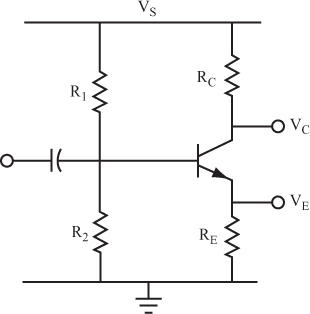These questions test your understanding of the material presented in this chapter. Use a separate sheet of paper for your diagrams or calculations. Compare your answers with the answers provided following the test.
1. What is the main problem with the amplifier circuit shown in
Figure 8.1? _____
2. What is the gain formula for that circuit? _____
3. Does it have a high or low gain? _____
Use the circuit shown in Figure 8.43 for questions 428.
4. Design an amplifier so that the bias point is 5 volts, and the AC voltage gain is 15. Assume β = 75, Rin = 1.5 kΩ, VS = 10 volts, and RC = 2.4 kΩ. Add capacitor CE to the circuit and calculate a suitable value to maintain maximum AC voltage gain at 50 Hz. What is the approximate value of this gain? _____
5. Repeat question 4 with these values: VS = 28 volts, β = 80, Rin = 1 kΩ, and RC = 10 kΩ. The bias point should be 14 volts and the AC voltage gain 20. _____
6. Repeat question 4 with these values: VS = 14 volts, β = 250, Rin = 1 kΩ, and RC = 15 kΩ. The bias point should be 7 volts and the AC voltage gain 50. _____
7. Design an emitter follower amplifier given that VS = 12 volts, RE = 100 ohms, β = 35, VE = 7 volts, and RC = 0 ohms. _____
8. Design an emitter follower amplifier given that VS = 28 volts, RE = 100 ohms, β = 35, VE = 7 volts, and RC = 0 ohms. _____
In questions 9211, the resistance and β values ...


